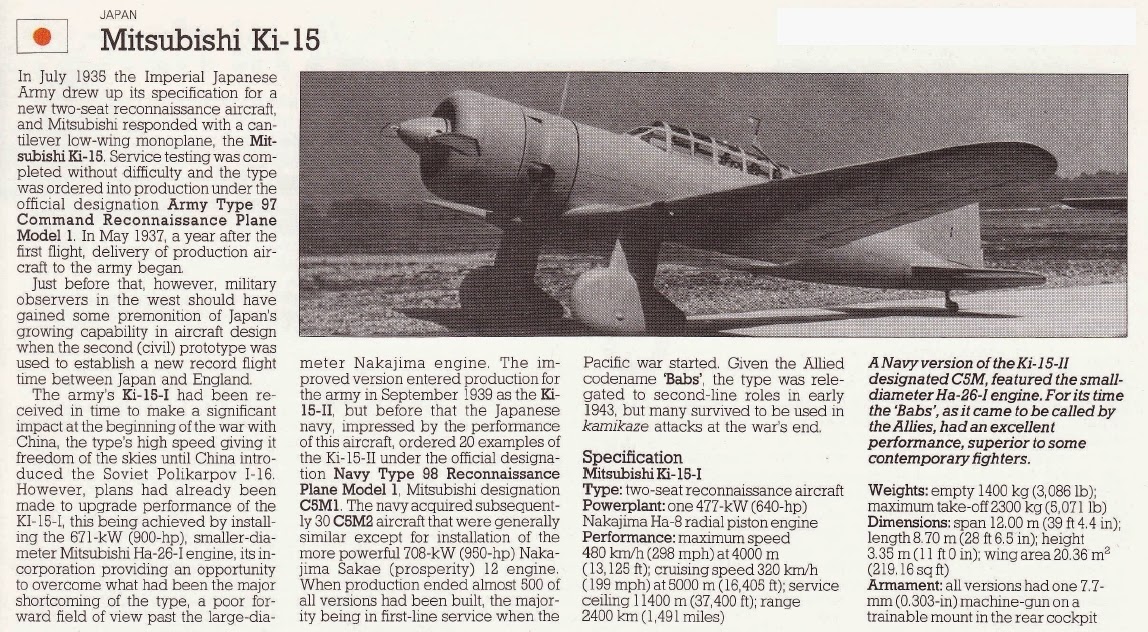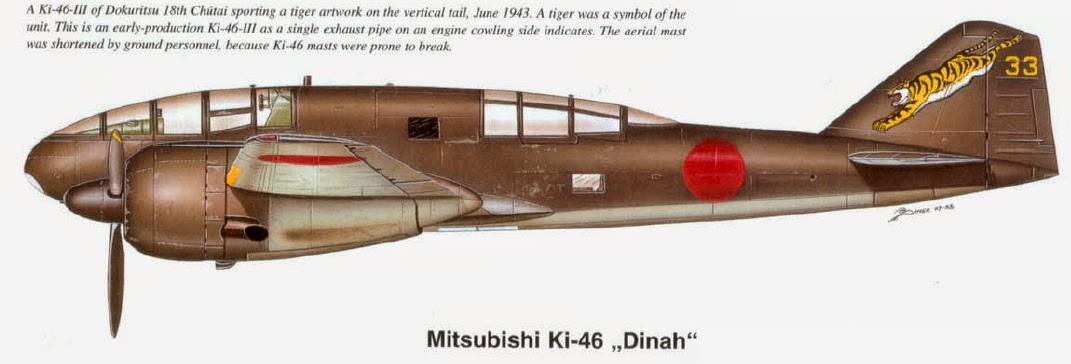





Soon after the first three Kawanishi H6K2s entered service in
January 1938, the Imperial Japanese Navy issued a development
contract to the company for a new large flying-boat to serve as a
replacement for that aircraft, appreciating that it would be two or
three year before a prototype would emerge. The estimate was fairly
accurate, the Kawanishi H8K1 prototype making a first flight on the
last day of December 1940, and while like its predecessor it was
powered by four engines, in other respects it differed
considerably. The high-set cantilever monoplane wing tapered in
both chord and thickness from wing root to wingtip and served also
to mount strutted and braced underwing stabilising floats at about
two-thirds span. The hull was more conventional, losing the
graceful lines of the H6K, and mounted at its rear a tail unit with
single fin and rudder. Power for the three prototypes and early
production aircraft was provided by four Misubishi MK4A Kasei
(Mars) 11 radial engines mounted in nacelles at the wing leading
edge. Accommodation was provided for a crew of 10, and defensive
armament comprised five 20-mm cannon in port and starboard blisters
and in nose, dorsal and tail turrets, supplemented by three 7.7-mm
(0.303-in) machine-guns in two side hatches and a ventral position.
Comprehensive armour protection was provided and the bulk fuel
tanks within the hull were partially self-sealing and incorporated
a carbon dioxide fire-extinguishing system.
The H8K was, therefore, an advanced aircraft, and designed to a
specification that called for performance superior to that of the
Short Sunderland. Not surprisingly, Kawanishi was greatly
disappointed with early tests which showed that the first of the
H8K1 prototypes was dangerously unstable on the water.
Modifications were begun immediately to rectify this situation,
including an increase in hull depth of 1 ft 9 3/4 in (0.55 m). New
tests showed considerable improvement, but the second and third
prototypes introduced the deeper hull and additional less major
hull modifications, as well as an enlarged vertical tail fin.
Service trials conducted with the modified flying-boats showed
acceptable water performance, still not as good as that of the H6K,
but they demonstrated such marked improvement in flight
characteristics that the navy had no hesitation in ordering the
type into production in late 1941 under the designation Navy Type 2
Flying Boat, which acquired subsequently the Allied codename
'Emily'. The type remained in operational use until the end of the
war, by which time construction of all versions totalled 167.
The initial H8K1 production version (16 built), which was the
same as the second and third prototypes, was soon superseded by the
major series version, the H8K2 (112 built) which introduced more
powerful Mitsubishi MK4Q engines. a revised tail unit, more
extensive armament and ASV radar. After being used for service
trials, the original H8K1 prototype was given Mitsubishi MK4Q
engines and converted for use in a transport role, then being
redesignated H8K1-L; it was later developed as a production
transport accommodating 29 to 64 passengers according to role,
being powered by the MK4Q engines and having armament reduced to
one 20-mm cannon and one 13-mm (0.51-in) machine-gun. Ordered into
production as the Navy Type 2 Transport Flying-Boat Seiku (clear
sky), the variant was built to the extent of 36 aircraft. Two early
production examples were used as development aircraft for an
improved version with retractable wingtip floats and a retractable
dorsal turret, being redesignated H8K3; they were later tested with
1,825-hp (1361-kW) Mitsubishi MK4T-B Kasei 25b engines under the
changed designation H8K4, but no production aircraft were
built.
Early production aircraft entered service in 1942, the type's
operational debut being made on the night of 4-5 March 1942 when
two aircraft based at Watje Atoll in the Marshall Islands, some
2,300 miles (3700 km) east of Pearl Harbor, were despatched to make
a bombing attack on Oahu Island. This operation involved refuelling
from a submarine at French Frigate Shoals, and it seemed unjust
that such an ambitious piece of planning was frustrated by heavy
cloud cover over the target area. Nevertheless, H8Ks proved highly
effective, and the type was deployed on bombing, reconnaissance and
transport missions, its heavy defensive armament making it a
formidable adversary.
Variants
H8K1 Prototype
One experimental prototype and two evaluation
aircraft.
H8K1 (Navy Flying Boat type 2, Model 11)
First operative model of series, 14
built.
H8K1-L
Redesignation of the first prototype, after
it was converted into a transport aircraft.
H8K2 (Model 12)
Version with more powerful engines and major
armament, equipped with search radar, 120 built.
H8K2-L Seiku ("Clear Sky"),(Model 32)
Transport version of H8K1. Armed examples
were equipped with two 20 mm Type 99 cannons and transport capacity
of 29-64 passengers (36).
H8K3 (Model 22)
Experimental version, H8K2 modified. Equipped
with retractable floats in wingtips, sliding hatch side gun
locations in place of the blisters, and a retractable dorsal turret
all in an effort to increase speed, 2 prototypes.
H8K4 (Model 23)
H8K3 with different engines, 2 converted.
Specifications (Kawanishi H8K2)
General characteristics
* Crew: 10
* Length: 28.15 m (92 ft 4 in)
* Wingspan: 38.00 m (124 ft 8 in)
* Height: 9.15 m (30 ft)
* Wing area: 160 m² (1,721 ft²)
* Empty weight: 18,380 kg (40,436 lb)
* Loaded weight: 24,500 kg (53,900 lb)
* Max takeoff weight: 32,500 kg (71,500
lb)
* Powerplant: 4× Mitsubishi Kasei 22 radial
engines, 1,380 kW (1,850 hp) each
Performance
* Maximum speed: 465 km/h (290 mph)
* Range: 7,150 km (4,440 mi)
* Service ceiling: 8,760 m (28,740 ft)
* Rate of climb: 8.1 m/s (1,600 ft/min)
* Wing loading: 153 kg/m² (31 lb/ft²)
* Power/mass: 0.22 kW/kg (0.14 hp/lb)
Armament
* Guns:
* 5 × 20
mm Type 99 cannon (one each in bow, dorsal, and tail turrets, plus
one each in two waist blisters)
* 5 × 7.7
mm (.303 in) Type 97 machine guns in fuselage hatches
* Bombs: 2 × 800 kg (1,764 lb) torpedoes or
1,000 kg (2,205 lb) of bombs or depth charges
Avionics
* Radar: Type 3 Mark 6 Model 4 (Type H6)































